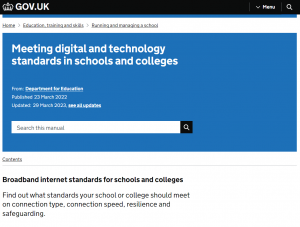Meeting Digital & Technology Standards In Schools
 On the 16th January 2024 the Department of Education published two new sets of standards for IT services and digital accessibility. The standards are intended as guidelines for schools, to support them in choosing the right digital infrastructure and technology.
On the 16th January 2024 the Department of Education published two new sets of standards for IT services and digital accessibility. The standards are intended as guidelines for schools, to support them in choosing the right digital infrastructure and technology.
Meeting the standards will help schools and MATs make informed decisions about technology, leading to safer, more cost-efficient practices and new learning opportunities for students.
Implementing the new standards will require broad involvement from staff across the entire school or trust such as; business professionals, finance and operational teams, teaching, SEN and disabilities staff, admin staff, designated safeguarding leads and data protection officers. Governors and trust leadership teams will be required to review, support, and challenge strategies. You may also need to involve suppliers such as broadband or cloud services to understand their protocols and include them in your plans.
Please note that the DfE are not making any additional funds available to support the implementation of standards, other than the Connect the Classroom programme.
Update 1: Digital leadership and governance standards
You are now advised to create a digital technology strategy that is reviewed every year. This will ensure your technology meets the needs of your school, your staff and students. It will help to ensure your budget, buying decisions and any risks are managed and training for staff and students is planned to allow them to use digital technology safely and effectively.
Having a strategy will avoid disruption to learning if the digital technology does not support curriculum delivery. It will also avoid potential compromises to safeguarding, provide better protection against cyber-attacks, and relieve budget pressures if older technology systems fail and need to be replaced.
The SLT digital lead should create a minimum 2-year strategy that should incorporate changes in digital technology and align with the School’s / Trust’s longer-term education development plans.
The following standards should also be considered when creating your digital technology strategy:
Filtering and Monitoring
Cloud
Broadband
To create your strategy, you will first need to complete the following if you don’t already do this:
You should have clear strategic oversight of all digital technology and how it fits with your development plan. Make sure your strategy is led by the needs of staff and students, not the technology itself. Help all staff to embed digital technology that meets staff and student needs. Ensure the planned use of technology is long term rather than short term, to avoid additional unplanned costs. It will also avoid exposure to safeguarding and security issues and help to ensure all existing technology is updated for compatibility with new digital technology.
You should keep a contracts register, asset register and information asset register to show what digital data, equipment, and systems you have. This will help improve and ensure a more effective management of all things ICT, such as keeping track of buying and licensing agreements to get better value for money, avoidance of renewal of subscriptions made in error and will also ensure safeguarding and cyber security software is kept updated.
There are 3 further related standards as part of keeping systems up to date:
So that your school can continue to operate and provide lessons in an emergency, such as a cyber-attack for example, you should have a process in place to review and update your disaster recovery and business continuity plans. This should include plans relating to digital technology; systems and equipment. Ensuring your business continuity plans are regularly reviewed and updated will prevent unplanned disaster recovery costs and potential loss of data or a data breach. Always test your recovery plans on a regular basis to identify any potential gaps.
Update 2: Laptop, desktop and tablet standards
Devices should meet educational needs and support the digital technology strategy. This will support curriculum planning and delivery, data and financial management and flexible and cross-site working.
Devices that do not meet with standards as part of the digital technology strategy could lead to lost learning, operational disruption, lack of security, operational overhead and may need to be repaired and replaced, costing more in the long run.
To meet this standard, follow the three steps:
Already referred to as part of the Digital leadership and governance standards, this should form part of your digital technology strategy.
Check how devices support the needs of students and staff, based on the school or college’s digital technology strategy. Look at how devices are being used, who uses them, where they are being kept and what they are being used for. This will help identify the number and type of devices needed, any specific physical requirements for devices and the level of technical support and training required.
The SLT digital lead should work with IT support to assess the security and technical requirements of devices. This will help determine whether new devices are required or if existing ones can be repurposed.
For more details on the new sections within the Digital and Technology Standards, please visit the DfE’s Update Page.
If you would like assistance in discussing your transition to cloud services, please contact us. We are industry-leading, award-winning experts in Cloud Services, Security, Safeguarding, Filtering and VoIP phone services for schools.
For more information call 01133 222 333 or email info@schoolsbroadband.co.uk
